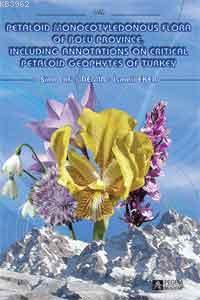9786053181453
540069

https://www.turkishbooks.com/books/petaloid-monocotyledonous-flora-of-bolu-province-including-annotations-on-critical-petaloid-geophyt-p540069.html
Petaloid Monocotyledonous Flora of Bolu Province, Including Annotations on Critical Petaloid Geophyt
4.8
The plants having underground storage organs such as bulbs, tubers rhizomes or rootstocks are called ?Geophytes (ground plants)" or "Cryptophytes (hidden plants)". Most Geophytes, after wintering, bloom in the early spring while some bloom in fall season. These gorgeous flowers are known as "the harbinger of spring".
Geophytes have excessively being collected, and consumed since ancient times for horticultural, food source and/or folkloric uses. Nowadays, they have been used in perfumery and the drug industry as well as in ornamental and food plants. Thus, the future of wild species are still under threat due to the excessive consumptions. Most species of geophytes are of global value and are listed in IUCN (International Union for Conservation of Nature), CITES (Convention on International Trade in Endangered Species of Wild Fauna and Flora), and Bern Convention. Turkey is found in the world's second geophytic center, which is the Mediterranean Basin. Besides, Turkey is the richest country in that area in terms of petaloid monocotyledones contributing around 1000 taxa.
This book comprehensively presents a new insight for regional revisions of geophyte diversity, as well as taxonomic remarks on some critical petaloid geophytes in Turkey, including a new verification, a new synonym, new approaches for confusing taxa and new IUCN threat categories for endemic and rare plants.
Geophytes have excessively being collected, and consumed since ancient times for horticultural, food source and/or folkloric uses. Nowadays, they have been used in perfumery and the drug industry as well as in ornamental and food plants. Thus, the future of wild species are still under threat due to the excessive consumptions. Most species of geophytes are of global value and are listed in IUCN (International Union for Conservation of Nature), CITES (Convention on International Trade in Endangered Species of Wild Fauna and Flora), and Bern Convention. Turkey is found in the world's second geophytic center, which is the Mediterranean Basin. Besides, Turkey is the richest country in that area in terms of petaloid monocotyledones contributing around 1000 taxa.
This book comprehensively presents a new insight for regional revisions of geophyte diversity, as well as taxonomic remarks on some critical petaloid geophytes in Turkey, including a new verification, a new synonym, new approaches for confusing taxa and new IUCN threat categories for endemic and rare plants.
The plants having underground storage organs such as bulbs, tubers rhizomes or rootstocks are called ?Geophytes (ground plants)" or "Cryptophytes (hidden plants)". Most Geophytes, after wintering, bloom in the early spring while some bloom in fall season. These gorgeous flowers are known as "the harbinger of spring".
Geophytes have excessively being collected, and consumed since ancient times for horticultural, food source and/or folkloric uses. Nowadays, they have been used in perfumery and the drug industry as well as in ornamental and food plants. Thus, the future of wild species are still under threat due to the excessive consumptions. Most species of geophytes are of global value and are listed in IUCN (International Union for Conservation of Nature), CITES (Convention on International Trade in Endangered Species of Wild Fauna and Flora), and Bern Convention. Turkey is found in the world's second geophytic center, which is the Mediterranean Basin. Besides, Turkey is the richest country in that area in terms of petaloid monocotyledones contributing around 1000 taxa.
This book comprehensively presents a new insight for regional revisions of geophyte diversity, as well as taxonomic remarks on some critical petaloid geophytes in Turkey, including a new verification, a new synonym, new approaches for confusing taxa and new IUCN threat categories for endemic and rare plants.
Geophytes have excessively being collected, and consumed since ancient times for horticultural, food source and/or folkloric uses. Nowadays, they have been used in perfumery and the drug industry as well as in ornamental and food plants. Thus, the future of wild species are still under threat due to the excessive consumptions. Most species of geophytes are of global value and are listed in IUCN (International Union for Conservation of Nature), CITES (Convention on International Trade in Endangered Species of Wild Fauna and Flora), and Bern Convention. Turkey is found in the world's second geophytic center, which is the Mediterranean Basin. Besides, Turkey is the richest country in that area in terms of petaloid monocotyledones contributing around 1000 taxa.
This book comprehensively presents a new insight for regional revisions of geophyte diversity, as well as taxonomic remarks on some critical petaloid geophytes in Turkey, including a new verification, a new synonym, new approaches for confusing taxa and new IUCN threat categories for endemic and rare plants.
Yorumlar (0)
Yorum yaz
Bu kitabı henüz kimse eleştirmemiş.









